Photons & Fusion Newsletter
February 2013
Photons & Fusion is a monthly review of science and technology at the National Ignition Facility & Photon Science Directorate. For more information, submit a question.
Test Station Achieves World-Class X-band Power Levels
A test station under development at LLNL has demonstrated capabilities and power levels that exist in only three other facilities in the world. The test station's XL-4 klystron and high-power solid-state modulator have demonstrated the ability to produce more than 50 megawatts of X-band (11.424-gigahertz) power for 400 nanoseconds at a repetition rate of ten times a second with "remarkable stability," according to Project Leader Roark Marsh.
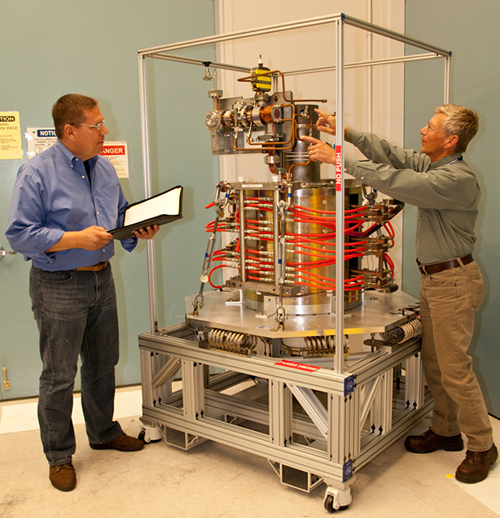 Chris Ebbers (left) and Tim Houck check the specifications of the XL-4 klystron shortly after it was delivered from SLAC last May.
Chris Ebbers (left) and Tim Houck check the specifications of the XL-4 klystron shortly after it was delivered from SLAC last May. X-band radiation is in the microwave portion of the electromagnetic spectrum; only the SLAC National Accelerator Laboratory in Menlo Park, CA, the CERN high-energy physics facility in Europe, and the KEK high-energy accelerator laboratory in Japan can produce X-band power at this level. Klystrons are used to generate microwave energy that drives particle beams; the XL-4 klystron was developed at SLAC and delivered to LLNL last summer. A solid-state 420-kilovolt modulator built by ScandiNova and based on technology developed at Livermore provides the high-voltage pulse that powers the klystron.
The klystron will power an all-X-band traveling-wave linear accelerator that includes an X-band photoinjector (a type of high-brightness electron beam source) known as the "Mark 1 rf (radio-frequency) gun," developed jointly by SLAC and LLNL. Principal Investigator David Gibson said the accelerator, which is being developed in a collaboration between NIF & Photon Science and the Laboratory's Physical and Life Sciences Directorate, will produce up to 50MeV (50-million-electron-volt) electron bunches.
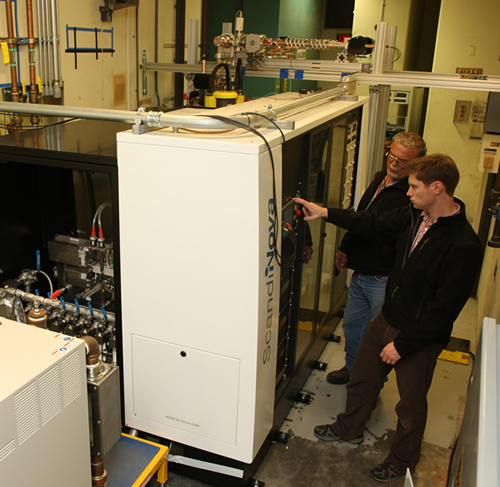 Gerry Anderson (left) and Roark Marsh examine the ScandiNova solid-state high voltage modulator.
Gerry Anderson (left) and Roark Marsh examine the ScandiNova solid-state high voltage modulator. NIF&PS Chief Technology Officer Chris Barty said the use of X-band power, instead of the S-band (2.856-GHz) power now used in many accelerators and in LLNL's previous Thomson-Radiated Extreme X-Ray (T-REX) system, enables the accelerator system to produce higher-energy electrons with greater accuracy in a shorter distance. This new accelerator will reduce the size of a new MEGa-ray system – a new class of light source that can be used to detect nuclear isotopes for basic science, homeland security, and other applications – to be four times smaller than T-REX, making possible a portable MEGa-ray source and detector for precision assays and images of nuclear waste canisters, cargo containers, nuclear fuel rods, and other objects that might contain uranium or plutonium.
X-band technology "provides us with a compact solution for our missions," Barty said.
Patent Issued for Novel Isotope Detector
A detector designed to work with a MEGa-ray source has received a patent from the U.S. Patent Office. Invented by Barty, the Dual Isotope Notch Observer (DINO) detector system is capable of measuring nuclear resonance fluorescence (NRF) reactions in materials induced by intense gamma-ray beams.
NRF is a process in which a nucleus, excited by gamma rays, re-radiates high-energy, very-narrow-bandwidth photons. Because NRF energy levels depend on the exact nuclear structure of the emitter, NRF spectra are isotope specific. When an object is exposed to a continuous flux of gamma-ray photons whose energy has been tuned to the NRF absorption resonance in the isotope of interest, the interrogating photons would be highly penetrating and able to "see" through many centimeters of steel.
 An isotope detector system could detect a piece of uranium-235 smaller than five millimeters in less than a second. This speed and accuracy would make the system an excellent tool for examining nuclear waste canisters, cargo containers, trucks, and other objects that might contain uranium or plutonium.
An isotope detector system could detect a piece of uranium-235 smaller than five millimeters in less than a second. This speed and accuracy would make the system an excellent tool for examining nuclear waste canisters, cargo containers, trucks, and other objects that might contain uranium or plutonium. The DINO detector system is being designed to require minimal operator intervention and deliver minimal dose to the object, while also providing high throughput for potential application at commercial seaports, airports, and other points of entry.
National Academies Recommend 'High Priority' IFE Research on NIF
After a two-year study, a National Academies (National Research Council) committee has concluded that the potential benefits of inertial fusion energy (IFE) justify it as part of the long-term U.S. energy R&D portfolio,  and that the target physics programs on NIF (and related facilities) "should receive continued high priority." NIF is "of great potential importance for advancing the technical basis for IFE research," the committee's final report says.
and that the target physics programs on NIF (and related facilities) "should receive continued high priority." NIF is "of great potential importance for advancing the technical basis for IFE research," the committee's final report says.
Issued on Feb. 20, the report, An Assessment of the Prospects for Inertial Fusion Energy, describes and assesses the current status of IFE research in the United States; compares the various technical approaches to IFE; and identifies the scientific and engineering challenges associated with developing inertial confinement fusion (ICF) as an energy source. It also provides guidance on an R&D roadmap for a national program focusing on the design and construction of an inertial fusion energy demonstration plant, such as the one proposed by LLNL's Laser Inertial Fusion Energy (LIFE) concept.
For more information, see the LLNL News Release. To view or download a prepublication copy of the report, click here.
NIF Petawatt Laser Moves Onto Fast Track
With the installation of new power cables for the Advanced Radiographic Capability (ARC) during the February NIF Facility Maintenance and Reconfiguration Period (see February NIF Status Update), 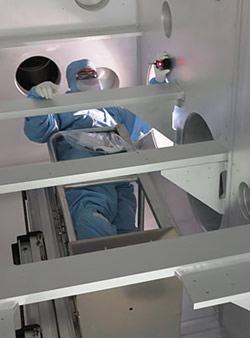 Dominic Griggs operates the laser surveying tool used to set alignment points in the 11-foot-high ARC parabola vessel.NIF's petawatt (quadrillion-watt) laser system is now moving on the path to completion. "It's been a large effort to get it designed," said Project Manager Greg Tietbohl, "and we're now at the stage of getting the hardware moved into NIF and making it work."
Dominic Griggs operates the laser surveying tool used to set alignment points in the 11-foot-high ARC parabola vessel.NIF's petawatt (quadrillion-watt) laser system is now moving on the path to completion. "It's been a large effort to get it designed," said Project Manager Greg Tietbohl, "and we're now at the stage of getting the hardware moved into NIF and making it work."
The primary work in NIF at present is the installation of all the ARC utilities, including electrical cabling, vacuum and ventilation systems, platforms, and cleanrooms. After this work is done, the large-aperture optical mounts, diagnostics, and front-end systems will be installed.
When complete, ARC will be the world's most energetic short-pulse laser, capable of creating picosecond-duration laser pulses to produce energetic x rays in the range of 50-100 keV (thousand electron volts) for backlighting NIF experiments. ARC is designed to deliver kilojoule laser pulses with adjustable pulse durations from 1 to 50 picoseconds and a peak focused intensity above 1017 W/cm2.
ARC uses up to four NIF beamlines, propagating two short-pulse beams per NIF aperture in a split-beam configuration. Staggering the arrival of the eight ARC beamlets onto backlighter targets will produce an x-ray "movie" to diagnose the fuel compression phase leading up to ignition of a cryogenic deuterium-tritium target with tens-of-picoseconds resolution. "ARC is important to help us understand what's happening in the compressed core of NIF targets," said John Edwards, program director for inertial confinement fusion.
ARC will also enable new experiments in frontier science and high-energy-density stewardship science.
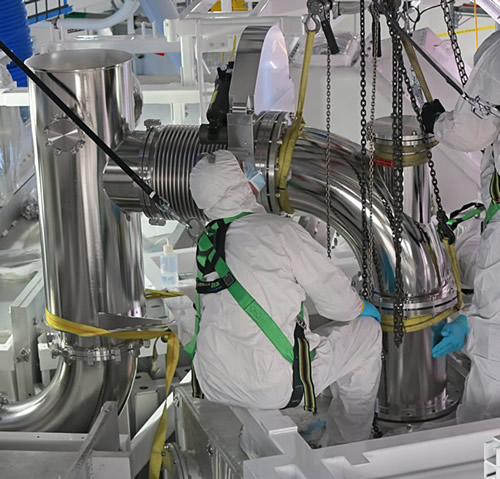 Rigging lead Eric Downing installs the final large ventilation system piping interconnection between the ARC compressor and parabola vessels. The system will provide air suction during entry of the vessels as part of the system’s confinement envelope.
Rigging lead Eric Downing installs the final large ventilation system piping interconnection between the ARC compressor and parabola vessels. The system will provide air suction during entry of the vessels as part of the system’s confinement envelope. NIF and Jupiter Laser Facility User Groups Meet
The NIF and Jupiter Laser Facility (JLF) User Groups held a joint meeting Feb. 10-13 at the Laboratory, with about 180 users and potential users from around the world attending. About 70 attendees were students and postdocs.
The meeting, chaired by NIF User Group Chair Justin Wark and JLF User Group Chair Carolyn Kuranz, included presentations about the status of NIF and JLF experiments and platforms and the NIF Ignition Program, and the status and path forward for fundamental scientific research on these facilities. Specific research topics included excited-state nuclear science and exploring giant planets with NIF; and the thermodynamics of planetary impact events, laser wake field acceleration, and studies of fast electron transport and magnetic collimation at the JLF.
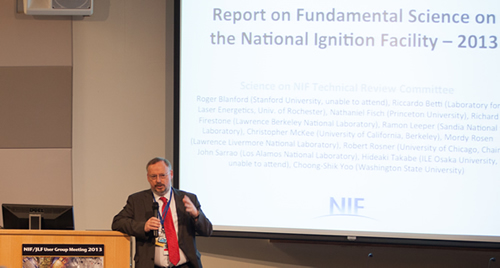 NIF User Group Chair Justin Wark discusses opportunities for fundamental science research on NIF at the NIF/JLF User Group meeting.
NIF User Group Chair Justin Wark discusses opportunities for fundamental science research on NIF at the NIF/JLF User Group meeting. The meeting included about 80 poster presentations, a Young Researcher Forum led by LLNL's Tammy Ma, a demonstration of user information technology resources by Casey Allen, and a discussion of opportunities for NIF/academic collaborations led by Justin Wark and Chris Keane. Following the meeting's wrap-up discussion on Feb. 13, attendees were given the opportunity to tour both NIF and JLF.
"The NIF User Group is grateful to the NIF Directorate, and to the Lab, for hosting and help in organizing this year's NIF User Group meeting," Wark said. "The meeting was well-attended, and the clear highlights were the poster sessions, where the young researchers in particular could show the excellent science they are doing. Coordinating the meeting with the JLF users proved a huge success, and demonstrated the power of both large and small facilities to do great research.
"The power of the NIF, with its exquisite and delicate pulse shaping, make it a unique facility to perform science, unparalleled in the world," he said. "However, the fielding of experiments has proven complex, and the challenge we must now address before our next meeting is to grow the basic science program on the NIF, with more shots for the academic users, so that several University groups can report successes on the NIF next year."
Progress toward Fusion Energy Described at AAAS Annual Meeting
LLNL's work on fusion technology was highlighted during a Feb. 16 session on fusion energy at the annual meeting of the American Association for the Advancement of Science. Titled "Worldwide Progress Toward Fusion Energy," the session explored the current status of fusion energy as two complementary approaches, inertial confinement and magnetic confinement fusion, are entering new experimental regimes.
LLNL's Debbie Callahan, group leader for inertial fusion target design, discussed experimental techniques and results on the path to achieving controlled fusion in the laboratory using NIF. Also during the symposium, Mike Dunne of NIF&PS described plans for commercial delivery of a demonstration fusion power plant known as LIFE. He said recent work has been driven by the requirements of likely end-users, including economic, social and policy considerations.
The session also covered the status of ITER, the international magnetic fusion facility now under construction in France, other magnetic fusion projects, and alternative approaches to inertial confinement fusion. NIF Director Ed Moses and Miklos Porkolab from MIT were the conveners of the session.
X-Ray Scattering Measurements in Shock-Compressed Aluminum
Warm dense matter (WDM), a complex state of matter that occurs during inertial confinement fusion (ICF) experiments, is characterized by temperatures usually associated with plasmas but at densities similar to solids. In addition to shedding light on the implosion phase of ICF experiments, the study of WDM also represents laboratory analogues of astrophysical environments found in the interior of planets and the crusts of old stars.

In a Physical Review Letters paper published online on Feb. 5, LLNL researchers and colleagues in the United States and the United Kingdom reported on the first observations of the strong ion-ion correlation peak characteristic of WDM. Experiments at the OMEGA Laser Facility at the University of Rochester demonstrated the ability of simultaneous angularly, temporally, and spectrally resolved x-ray Thomson scattering in laser-driven shock-compressed aluminum to resolve the ion-ion correlation in WDM and obtain an accurate measurement of compression.
The researchers said the results show that theoretical models for the ion structure must take the complex interactions in WDM into account in order to agree with the data. The results also demonstrate a new, highly accurate diagnostic to directly measure the state of compression of WDM.
LLNL researchers Tammy Ma, Tilo Döppner, Otto Landen, Arthur Pak, and Siegfried Glenzer were joined on the paper by collaborators from UC Berkeley, UCLA, SLAC National Accelerator Laboratory, and the Centre for Fusion, Space and Astrophysics at the University of Warwick in the UK.
Positron Beam Emittance Produced by Intense Lasers
The emittance values of positron beams produced by intense lasers have been measured for the first time by LLNL researchers and their collaborators. In a Physics of Plasmas paper published online on Jan. 31, the researchers reported that the laser-produced positrons have a geometric emittance comparable to the positron sources used at existing accelerators.
With 1010 to 1012 positrons per bunch, this low emittance beam, which is quasi-monoenergetic in the energy range of 5 to 20 million electron-volts (MeV), may be useful as an alternative positron source for future accelerators.  The emittance values were derived through measurements of positron beam divergence and source size for different peak positron energies under various laser conditions.
The emittance values were derived through measurements of positron beam divergence and source size for different peak positron energies under various laser conditions.
The experiments were performed using ten-picosecond laser pulses at 1.054-micron wavelength from LLNL's Titan laser and the OMEGA EP laser at the Laboratory for Laser Energetics (LLE), University of Rochester. The lasers irradiated a one-millimeter-thick, two-mm-diameter solid gold target with very short-duration, intense laser pulses.
The possible use of laser-produced positrons as a new source for accelerators rests on the potential advantages of a much reduced physical size, lower cost, and improved beam characteristics: particles per pulse, energy span, and beam emittance. Lead author Hui Chen of LLNL was joined by LLNL colleagues Andy Hazi, Anthony Link, Scott Anderson, Jeff Gronberg, Nobuhiko Izumi, Riccardo Tommasini, and Scott Wilks, along with collaborators from the SLAC Linear Accelerator Center, LLE, the Department of Applied Science at UC Davis, and the Department of Electrical and Computer Engineering at the University of Alberta.
Mode Converter Boosts Power in Rectangular-core Fiber Amplifiers
Fiber lasers have the potential to generate high average power with excellent beam quality and efficiency, compactness, and reliability. Fiber-laser amplifiers using conventional large-mode-area and/or photonic-crystal fibers can output a maximum of about 36 kilowatts (kW) with diffraction-limited (ideal) beam quality.
LLNL researchers are working to increase the output of these lasers by changing the shape of the waveguide from a circularly symmetric fiber to a rectangular, or ribbon-shaped, fiber. The Feb. 13 issue of Laser Focus World described a mode-converter system that will enable rectangular-core fibers to extend single-aperture fiber-laser amplifier output to more than 100 kW while retaining diffraction-limited beam quality.
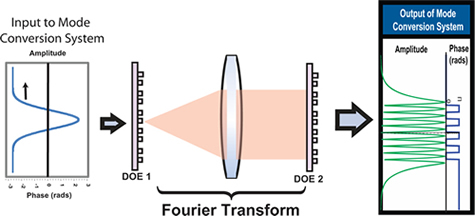 A mode converter using diffractive optical element-based phase plates developed at LLNL operates with near-80-percent efficiency.
A mode converter using diffractive optical element-based phase plates developed at LLNL operates with near-80-percent efficiency. The mode converter, developed by physicist Arun Sridharan and his colleagues in the NIF&PS Fiber Laser Group, uses two diffractive optical elements (DOEs) or "phase-only" plates implemented using spatial light modulators. "In the future, phase plates fabricated in fused-silica glass can be used to build the mode converter to withstand the high-power output from rectangular-core fiber amplifiers," Sridharan said. "These mode converters can also be leveraged for improved power extraction in bulk solid-state amplifiers."
Hydrodynamic Instability Experiments on NIF Discussed at HED Seminar
Alexis Casner of the French Atomic Energy Commission (CEA) discussed proposed experiments to study Rayleigh-Taylor (RT) instability during NIF implosions at a High Energy Density (HED) Science Seminar on Feb. 14. RT instability occurs when a dense fluid is accelerated against a less dense fluid, causing fingers of dense material to interpenetrate the less dense fluid, leading to a mixture of the layers of fluid.
NIF provides a unique platform to study the physics of nonlinear and turbulent mixing flows in HED plasmas because it can accelerate targets over much larger distances and longer time periods than other laser systems. Casner's talk described the goals of a NIF fundamental science proposal aimed at understanding how ablative RT instability drives hotspot mix in NIF implosions, as well as the cause of increased mode coupling in ablative flows and the destabilizing effect of ablation-induced vorticity on RT instability growth.
NIF Visitors
 Brig. Gen. James C. Dawkins, Air Force Principal Assistant Deputy Administrator for Military Applications in NNSA's Office of Defense Programs, toured NIF on Feb. 26. Gen. Dawkins was accompanied by Col. George Sakaldasis of the LLNL National Security Office (left) and Chris Keane of NIF&PS. Also visiting NIF, on Feb. 25, was retired Air Force Gen. Charles "Chuck" Wald, former Deputy Commander of U.S. European Command.
Brig. Gen. James C. Dawkins, Air Force Principal Assistant Deputy Administrator for Military Applications in NNSA's Office of Defense Programs, toured NIF on Feb. 26. Gen. Dawkins was accompanied by Col. George Sakaldasis of the LLNL National Security Office (left) and Chris Keane of NIF&PS. Also visiting NIF, on Feb. 25, was retired Air Force Gen. Charles "Chuck" Wald, former Deputy Commander of U.S. European Command.  NIF&PS Deputy for NIF Jeff Atherton (left) describes the NIF Laser Bay to Science News reporter Andrew Grant, who visited NIF on Feb. 8 to gather information for an article on NIF's progress toward ignition.
NIF&PS Deputy for NIF Jeff Atherton (left) describes the NIF Laser Bay to Science News reporter Andrew Grant, who visited NIF on Feb. 8 to gather information for an article on NIF's progress toward ignition. Photo of the Month: NIF Capacitor Bay
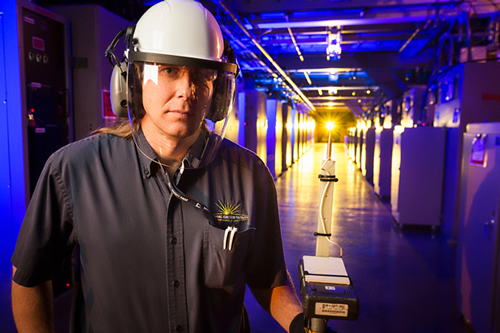 Power conditioning operator Seth Robinson conducts tests in one of the four NIF capacitor bays. The capacitor bays house NIF's power conditioning system, which delivers 400 megajoules of stored electrical energy to the laser system's 7,680 flashlamps. Photo by Damien Jemison.
Power conditioning operator Seth Robinson conducts tests in one of the four NIF capacitor bays. The capacitor bays house NIF's power conditioning system, which delivers 400 megajoules of stored electrical energy to the laser system's 7,680 flashlamps. Photo by Damien Jemison. 



